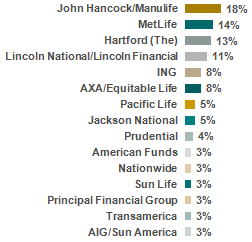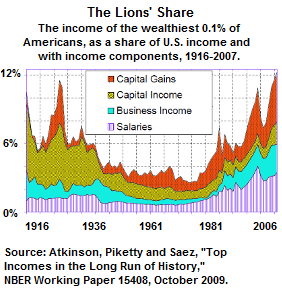When Bank of America acquired Merrill Lynch in the fever of the financial crisis, BoA CEO Ken Lewis was like the proverbial dog that finally caught the car it was chasing. Lewis got the wirehouse he yenned for, but lost his job in the aftermath.
Lewis’ chair hasn’t been refilled, but life has settled enough at the firm for it to exploit the merger’s synergies. For instance, it has re-launched Merrill’s 2006 My Retirement Paycheck program under the trademark My Retirement Income.
“This is an evolution of My Retirement Paycheck,” Aimee DeCamillo, head of Personal Retirement Solutions for Merrill Lynch Global Wealth Management told RIJ. “That was one of our initial forays” in this area.
The program will connect 15,000 financial advisors, supported by 800 retirement specialists, with Bank of America’s retail banking customers through a network of 6,100 offices and 18,000 ATM machines as well as online and mobile banking.
“Merrill Lynch brought a leadership position in retirement, and Bank of America has a relationship with one out of every two households in an America,” DeCamillo said. [Dan McNamara, who had led retirement initiatives at Bank of America, is no longer with the company, DeCamillo said. Two months ago, Andy Sieg was recruited from Citi to run Bank of America-Merrill Lynch Retirement Services. Sieg was at Merrill Lynch before moving to Citi.]
The new plan is “a comprehensive income plan created for the client. It asks, ‘What does next 12 months look like for you’ and looks at distinct pools of assets in the context of managing four primary risks-the traditional retirement risk components.”
The assets go into “periodic, distinct buckets geared to help take the emotion out of investing. For instance, there’s a long-term bucket that protects against inflation and longevity risk. Or, it can be useful for the high net worth client who wants to set aside legacy assets,” she said.
“If an insurance product is suitable for the client and it complements the clients long-term plan, then an annuity can be included. But the [income solution] could be laddered bonds or CDs,” DeCamillo said.
The new program “is available to all our advisors, but there are always advisors on the leading edge and we’ve spent a lot of time with our top tier advisors,” she added. “There’s no fee for the service itself. It’s available through the regular retail relationships. We soft launched the product internally. We’ve created a whole host of seminars and training programs.”
Here’s how Merrill Lynch described My Retirement Paycheck three years ago: It “can track your income and spending, while frequently updating your portfolio’s value. They’ll also warn you if any of these deviate from your financial plan. They work by routing all your income — Social Security and pension checks, as well as interest and dividend income — into a single account held at the firm. Any money you spend should also be withdrawn from this single account.”
Here’s how BofA describes the new program:
Merrill Lynch Global Wealth Management has launched My Retirement IncomeTM, a feature within the Merrill Lynch Retirement Income Service that connects customized retirement income planning with the Bank of America retail banking network.
My Retirement Income allows clients nearing or in retirement to automatically transfer funds from a consolidated Merrill Lynch cash management account into a Bank of America deposit account on a periodic basis for simplified retirement income distribution and management.
Retirement income transferred into a Bank of America deposit account can be accessed through the nation’s largest retail banking network, which includes more than 6,000 retail banking offices, more than 18,000 ATMs, mobile banking, and online banking.
Merrill Lynch Retirement Income Service is a comprehensive retirement income management solution that:
- Helps clients to convert their retirement nest egg into retirement income.
- Enables Merrill Lynch advisors to help retirees track their spending behaviors, manage cash flow and adjust investment strategies to ensure that their savings last throughout their lifetime.
Also introduced today is the Merrill Lynch Retirement Income Framework, a proprietary retirement income planning and investment approach enabling Merrill Lynch advisors to advise clients on retirement income strategies, taking into account a client’s individual risk tolerance, retirement consumption needs, and appropriate asset allocation.
The approach was designed to better enable clients to meet short-term consumption needs, optimize long-term investment opportunities, and marshal excess savings to maximize the value of their legacies and intergenerational transfer of wealth. Merrill Lynch Financial Advisors have access to this new framework to complement and evolve their existing strategies when working with clients.
The foundation of the new Merrill Lynch Retirement Income Framework is a segmented investment approach best suited for clients nearing and in retirement that divides assets into three distinct portfolios: Consumption Funding (short-term savings and investments), Longevity & Income Replacement (intermediate-term investing), and Wealth Structuring (long-term investing).
The investment framework also takes into consideration and is designed to help mitigate common risks associated with retirement income plans, including longevity, inflation, asset allocation, healthcare and planning risks.
© 2009 RIJ Publishing. All rights reserved.


 You might still think of Taiwan as a crowded island of cheap factories off the coast of China, instead of the beautiful, subtropical, high-tech place that it is. You might also imagine that the Taiwanese don’t have much in common with Americans regarding retirement.
You might still think of Taiwan as a crowded island of cheap factories off the coast of China, instead of the beautiful, subtropical, high-tech place that it is. You might also imagine that the Taiwanese don’t have much in common with Americans regarding retirement. Before that can happen, however, legislative changes will have to occur. Retirement finance here, as everywhere, has complex political ramifications. Promises of higher pension payouts and even outright payments have long played a role in local election campaigns in Taiwan, according to Lin Wan-I, a sociologist at National Taiwan University.
Before that can happen, however, legislative changes will have to occur. Retirement finance here, as everywhere, has complex political ramifications. Promises of higher pension payouts and even outright payments have long played a role in local election campaigns in Taiwan, according to Lin Wan-I, a sociologist at National Taiwan University.






